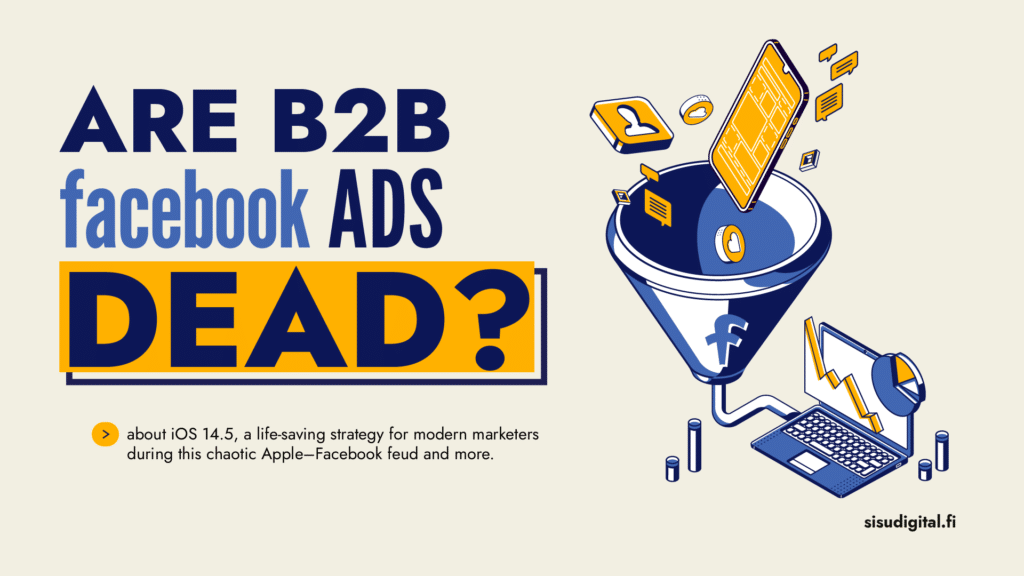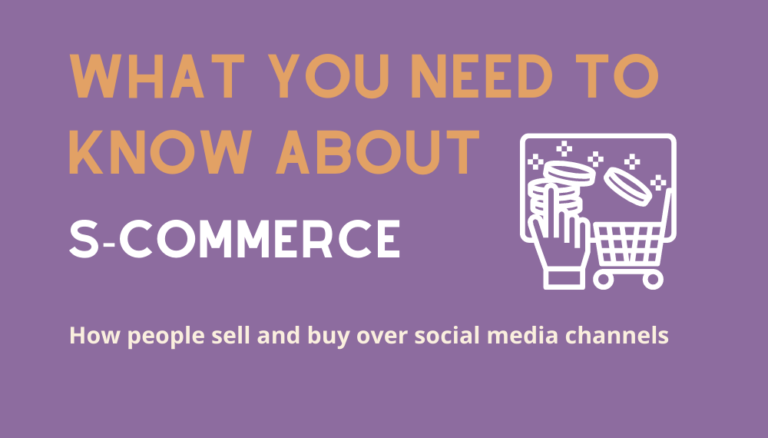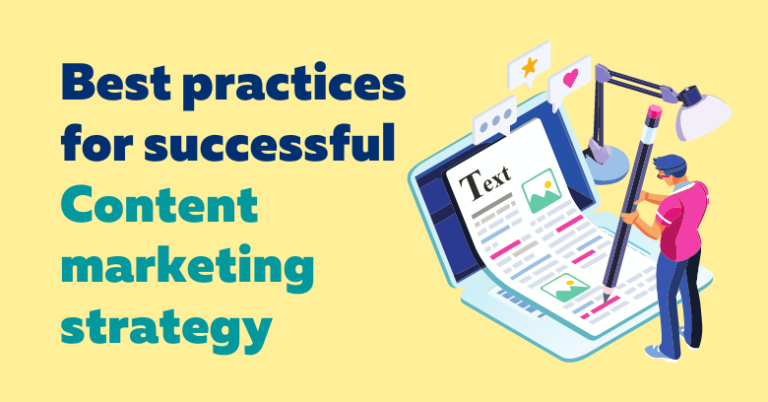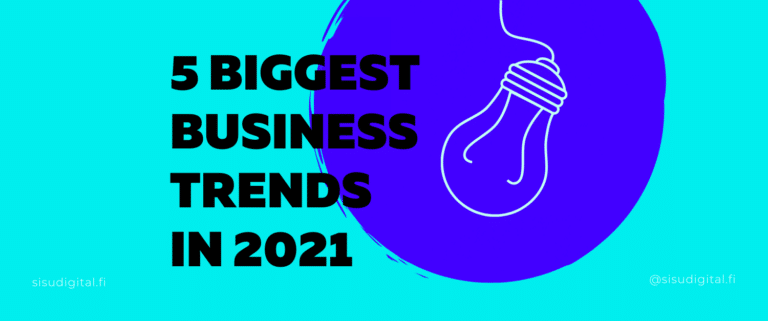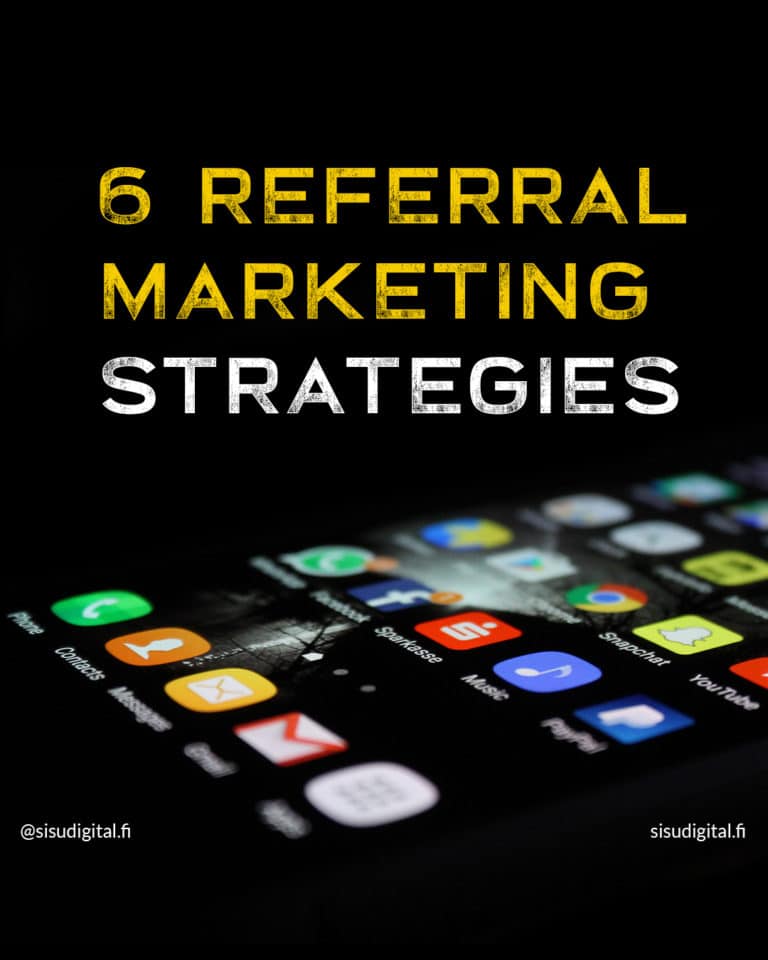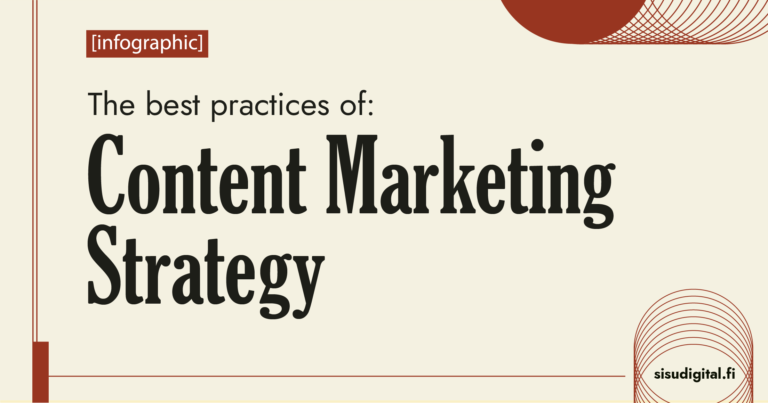With a Facebook B2B content marketing funnel that has been optimized, this whole iOS 14.5-versus-Facebook beef can be… less scary.
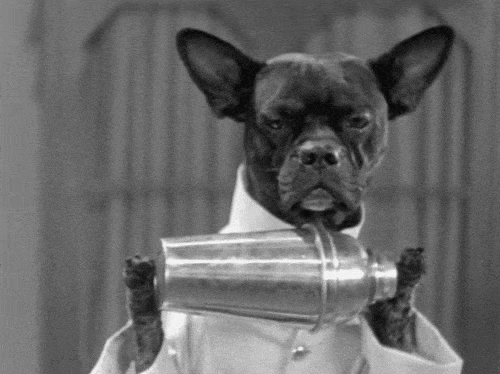
The title is a mile long and a mouth-full. But this is important business.
First thing first—
Are B2B Facebook ads dead?
B2B marketers and SMEs’ nightmare came to life following iOS 14.5 release on April 26th, 2021. This is no news (for some), but the blow it’s dealt on Facebook advertising and advertisers still aches.
Among a barrage of cool new features, the update’s App Tracking Transparency (ATT) prompt has been the most remarkable as it stirs up a storm in the Silicon Valley. Facebook and the likes of it, where user data is a lucrative revenue stream (they use that information to help companies target their ads), have been voicing their protest against ATT for months.
In the promotion video for ATT in iOS 14.5, Apple depicts how apps are collecting data such as your “age, location, health information, spending habits and your browsing history to name a few.” They unveil how some apps, seemingly hinting at the likes of Facebook, are “taking more data than they need, sharing it to third parties like advertisers and data brokers” without user’s knowledge or explicit permission.
This move of Apple essentially spells the end of IDFA (identifier for advertisers), a unique string of code that companies like Facebook use to track user activity across iOS apps and services. This is how Facebook knows I have been looking at, for example, website design services. For years, this pipeline of user data has been what B2B marketers depend on to effectively map out target audience and plan campaigns.
At the time of writing, which is a month after the launch of iOS 14.5, everything has been much more cut-throat for social media-dependent B2B advertisers.
Users have more control with the possibility to “Ask App Not to Track” every time they download a new app, and they can opt out for good in the settings. It turns out that, when given a choice, most would appreciate privacy (shocking!) Roughly 15% of worldwide users choose to opt in across all apps—less so among U.S. users, at merely 6%.
So—are B2B Facebook ads dead?
With LinkedIn as the preeminent B2B social platform, Facebook’s unique selling points were the low CPMs and its on-the-money conversion optimization technology. Facebook used to excel at optimizing campaigns to the right KPIs thanks to its colossal user database. Getting hit by ATT—what’s left for B2B Facebook marketing?
Apple has dealt Facebook a mighty blow. The social media juggernaut, as an advertising platform, is suffering the consequences along with its partners, B2Bs and B2Cs alike (the ones who pay Facebook to advertise their products/services).
Ads campaigns now can’t be optimized, targeted or attributed to specific profiles, or much less so than before. “This essentially deprecates the ability to target and track advertising at an individual level without the use of logged in email addresses,” says John Lee, corporate chief strategy officer at performance marketing agency Merkle.
ROI may tank significantly while you’re still blowing through your usual Facebook advertising budget. Many B2Bs are struggling with higher CPMs (cost per thousand impressions) for Facebook ads, while receiving low-quality traffic. It’s not ideal.
B2Bs marketers face another issue as Facebook itself removes the 28-day attribution option and instead, default a to 7-day window. The old attribution window allowed marketers to see a lead’s activity 28-days prior to when they converted. With longer sales cycles, B2B companies require as much user data as they can get to successfully register a purchase at the end of the cycle. B2Bs lost this big leverage when Facebook decided to stop supporting 28-day click, 28-day view, and 7-day view windows. Because this action is from Facebook per se, Android-using and iOS-using marketers are getting affected alike.
Keep in mind that there will not be real-time reporting on Apple’s initiative. Data is delayed for up to three days after the event has occurred. Facebook may not be capable to measure ad performance at the user level, or have restricted access to certain group of data.
So well—B2B advertising on Facebook is not… dead, just yet. It’s not exactly thriving, either. It is time B2B marketers stepped up from plain Facebook ads. We must focus on a more sustainable, result-driven lead generation and conversion strategy. Introducing: Content marketing funnel strategy optimized for iOS 14.5.
Content marketing funnel – optimized for iOS 14.5
…as a regular one wouldn’t suffice.
Even if you think your current B2B content marketing funnel strategy for Facebook are already as perfect as it can ever be, and you are only here for the tips—keep skimming through. You may discover some blind spots.
Anyhoo, tips are placed at the end of all following sections. Let’s get down to it.
1. Understand your B2B content marketing funnel
You cannot fight a fire blindfolded. As we start to tackle optimizing content marketing funnel for iOS 14.5, let’s quickly discuss the content marketing funnel itself.
A content marketing funnel is a strategic system that take cold/lukewarm prospects through a step-by-step content flow and convert them into customers.
With 4 stages, from top to bottom: awareness, interest, consideration and purchase, the basic content marketing funnel typically looks like this—
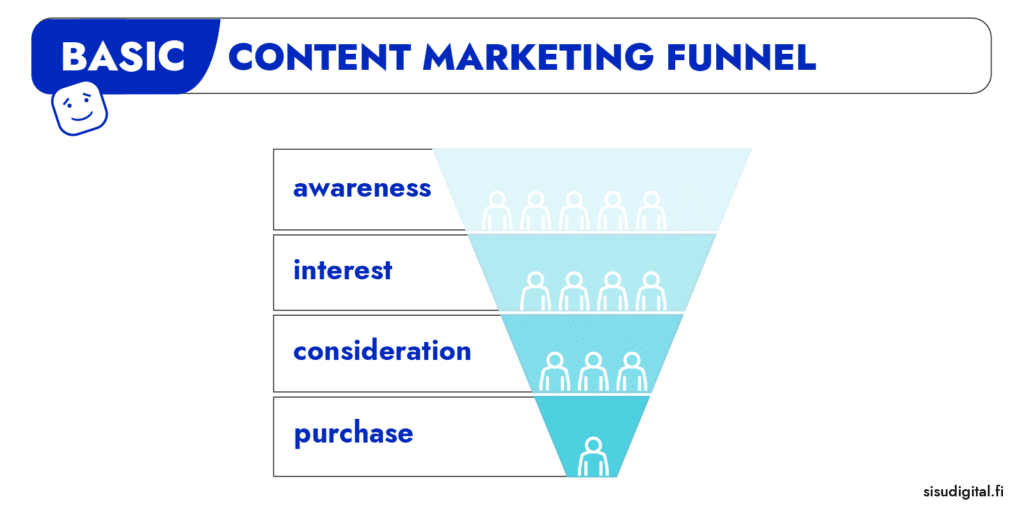
It’s self-explanatory as to why you must understand your content marketing funnel before attempting to optimize it. Test yourself now with some questions below.
- What lead businesses to discover your company? Which channels or sources are the main ones?
- What are milestones in the customer journey (e.g. homepage visit, initiating conversation with chatbot, filling form)?
- Which offerings can be best paired with each milestone crossed (e.g. whitepaper, template, discount code)?
- How long is the journey from top to the bottom of funnel (e.g. x days, x months, or x years)?
- Where are the possible leaks and hiccups? Do you have secondary funnels to save the “escaped” leads?
Leave no stone unturned and we already have a decent skeleton.
Actionable tip – content marketing funnel optimization for iOS 14.5:
- Assess iOS users’ impact on your B2B: see how many purchases, leads, and other events are coming from iOS devices (using the Breakdown reports on Facebook or Google Analytics) compared to the total number. This aids in adjusting/visualizing the funnel and not to forget other systems such as Android and Windows.
2. Leverage your B2B Facebook ads account
The way you organize your Facebook ads can either aid you in effectively managing and optimizing your campaigns, or void all of the efforts. While there are many ways to break it down, the structure of a B2B Facebook ads account should resemble this—
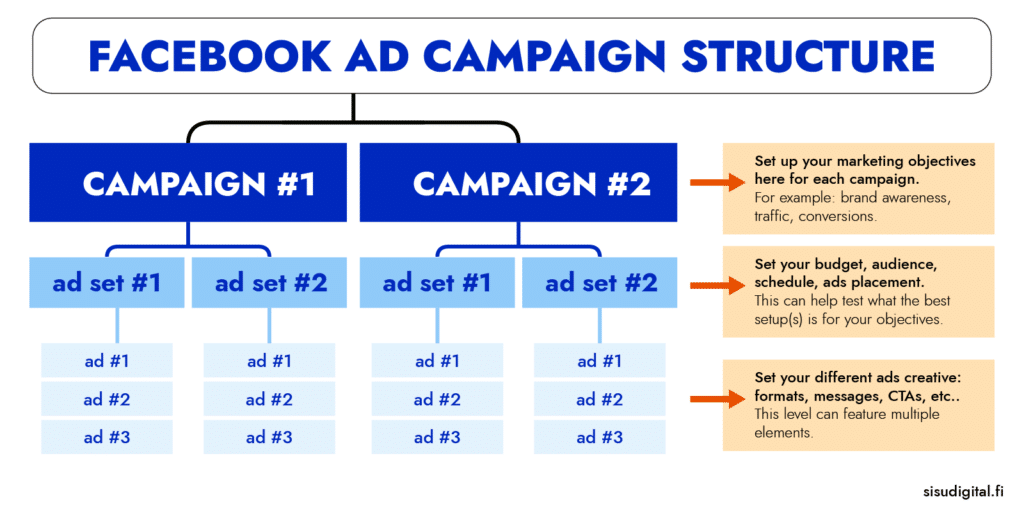
There are three factors needed to run Facebook ads: a campaign, ad set, and ad. Together, these factors make up what we call the campaign structure.
At the campaign level, you set the advertising objectives. Here you set the end goal for your ads, such as getting people to visit the landing page. You define your targeting strategy at the ad set level, setting up parameters like optimization settings, bid strategy, schedule and budget. Finally, within each ads are creative visuals and marketing messages—those that drive the audience to do what you’re trying to get them to do.
A solid, tried-and-true strategy is targeting prospects along every step of your content marketing funnel. This means having an account structure that matches your funnel stages.
The ultimate number of campaigns varies, considering what your B2B marketing funnel looks like and how granular or comprehensive you want to get.
Let’s walk through a standard campaign structure example with the three elements: campaign, ad set, and ad.
We follow the strategy of targeting prospects through stages of the content marketing funnel.
- Campaign #1: Top of funnel (TOF)
- Campaign #2: Middle of funnel (MOF)
- Campaign #3: Bottom of funnel (BOF)
As you have decided your ads objective while setting up the campaign (awareness, consideration, or conversion – more on this later on), your view in Ads Manager shows how relevant KPIs are tracking across the funnel, and a choice to review and adjust your campaigns.
Now, within campaigns, there can be multiple ad sets. You can set up your budget, schedule, ads placement, audiences, etc. and test how effective each is. Here’s an example:
- Ad set #1: Audience 1, Placement A, Offer x
- Ad set #2: Audience 1, Placement B, Offer y
- Ad set #3: Audience 2, Placement B, Offer x
- Ad set #4: Audience 2, Placement A, Offer y
Relevant KPIs for each are shown in your ad set view. Comparing ad performance of different ad sets helps you to understand how budget allocation should be adjusted, or test new offers and audiences within that funnel stage. Pay close attention to what works for you and what doesn’t.
Lastly, within ad set are ads—what your audiences see. The ad level is the perfect place to test different ads creative: ad formats, messages, CTAs, etc. For instance:
- Ad #1: Offer > Creative 1 > Copy 1 > CTA 1
- Ad #2: Offer > Creative 1 > Copy 2 > CTA 1
- Ad #3: Offer > Creative 2 > Copy 1 > CTA 2
- Ad #4: Offer > Creative 2 > Copy 2 > CTA 2
Without saying, you should keep the structure and element naming well organized. The standardized naming helps with editing and tracking performance without having to plow through the account looking for it. A neatly-structured ad account is crucial if you want to effectively manage and operate any campaign with any strategy.
Actionable tip – content marketing funnel optimization for iOS 14.5:
- Start at the top-to-middle of the funnel to target prospecting audiences. Such as whitepapers, checklists or tips—exactly like this blog we’re reading here. Resist the temptation to offer demos or trials, especially with a cold prospecting audience. This practice might not yield the quality or quantity of conversions you are looking for at earlier stages.
- Examine the audiences: Research for the best-performing conversion campaigns by identifying and analyzing interests, demographics and in-market segments reports (can be done on Google Analytics). Make sure that you have enough conversions on each segment, and rank them by conversion rate. This insight will tell you which are your current strongest audiences, and help you keep your targeting straight.
3. Marketing objectives for B2B Facebook campaigns are not created equal
Check out the image below. Facebook silos marketing campaign objectives into three categories: Awareness, Consideration, and Conversion.

These suggested objectives are NOT optimized for B2Bs ads.
Reach campaigns can effectively get your top-level content in front of prospects that are not familiar with the brand. However, for B2Bs without a robust content plan and some serious re-marketing strategies, these reach campaigns result in rather low ROI.
In the Consideration column, we have Engagement that doesn’t mean much for most small-and-medium-sized B2Bs. Fairly, App installs and Video views are still up for the challenge when prospects reach middle of the marketing funnel, but only if you have those requisite collaterals and the fund for them. Most B2Bs communicate through channels that are more organized and secured than Facebook messages. In the last column, Catalog sales and Store visits are, all things considered, meaningless to B2B marketers.
We are left with four B2B-compatible objectives: Brand awareness, Traffic, Lead generation, and Conversions. These objectives, from left to right, construct our ultimate B2B Facebook content marketing funnel.
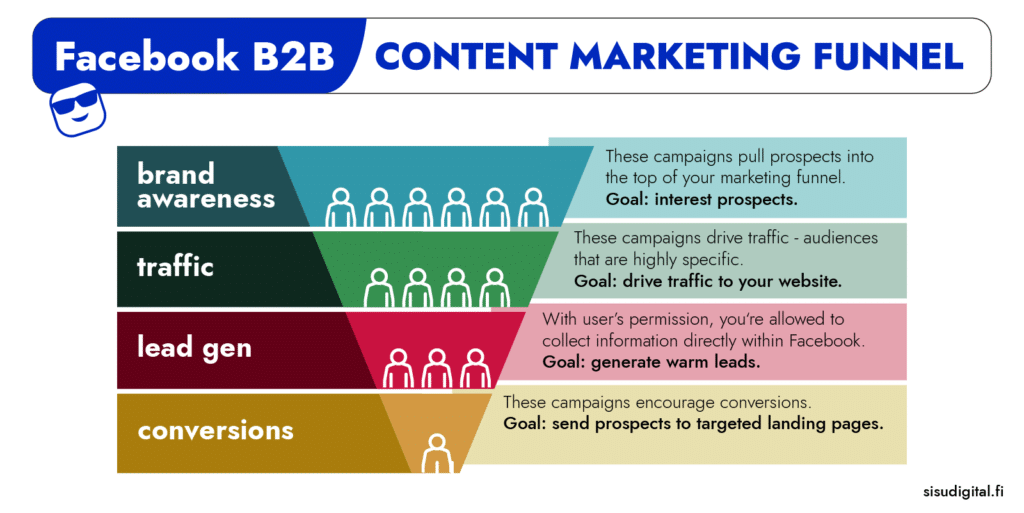
Let’s explore the funnel top-down.
At top of the funnel (TOFU), businesses are not ready to reach out or make a purchase. B2B sales cycle inherently takes longer from start to finish—it can easily be months before purchase. They would need more time, as well as information, to consider and turn to leads. Therefore, the main goal of TOFU is brand awareness: to encourage brand awareness from businesses’ decision-markers.
Middle of the funnel (MOFU) should focus on traffic and lead generation campaigns. This group of businesses’ decision-markers are aware of the problem they wish to solve, and they are shopping around for solutions. This is the stage where they gather information and consider available options. The goal here for B2B marketers is to: provide as much information as possible about the offered solution, position your business as the market leader by building trust and connection, and lead decision-markers to the convert stage.
At bottom of the funnel (BOFU), there are hot leads, or buyers, who are most likely to purchase your advertised solutions. This is a small audience, but of high-quality and most profitable. A marketer, aside from collaborating with other departments to close a sales, must retain good relations with these buyers, have strong CTAs and focus on conversion campaigns.
Worth noticing among the chaos are the Facebook pixels. Facebook pixel is an analytics tool—a JavaScript snippet—that allows you to measure the effectiveness of your B2B ads by tracking website visitor activity. It can easily be installed to WordPress sites. The iOS update means limiting to no more than 8 pixel events on a single domain. This restricts the amount of tracking available to advertisers.
Actionable tips – content marketing funnel optimization for iOS 14.5:
- There will be delayed and aggregated data. As stated before, real-time reporting is not supported on Apple’s initiative. Online conversion events are logged based on when the conversions occur and not the time of associated ad impressions.
- Consider focusing on reach- or traffic-based optimizations. Ads that use pixel tracking will be impacted. Conversion-focused campaigns are to be affected, while a strong traffic-driven campaign can be equally effective. It can generate leads, encourage sales and others just as well.
- Utilize Facebook pixels if you haven’t.
- Research and see what 8 specific pixel events are of priority to your B2B marketing strategy. Make informed decisions based on e.g. what information is the most valuable, what has proven to be more successful for retargeting… This helps you group the website visitors by the most important actions they take.
4. Target audience pairing—key to Facebook ads success
This step of building a content marketing funnel is about pairing the right audience with the right offer. Get as granular as you wish to. If you can consistently do this right, B2B Facebook ad can be a breeze in the park.
The audience can be created using Facebook’s multitude of targeting filters for advertisers, or sourced from your own database.
Identifying a business’s primary decision-makers on Facebook, though, can prove to be a bit tricky even with all the tools Facebook provides. The trick here is to layer dozens of distinguishing elements to create your ideal customers, a.k.a. customer persona.
As the prospects move down the funnel, it is important that you also narrow down the audience. Like a funnel that is widest at the rim, TOFU should target a large audience range to reach as many prospects as possible. Meanwhile, MOFU’s target audience can get a bit more specific and of higher quality. BOFU, the most profitable funnel stage, should have a small group of high-quality, potential buyers.
There may be cross-overs across funnel stages—that is when a qualification appears in more than one stage. For instance, MOFU’s and BOFU’s audience targeting may both include Newsletter sign-up.
It is worth noticing that there would be a decrease in overall custom audience sizes and accuracy of lookalike audiences (LAL). Facebook ad’s LAL feature takes a hit from ATT as a decrease in attribution window reduces the data points Facebook has to form connections between profiles.
Actionable tip – content marketing funnel optimization for iOS 14.5:
- Consider expand the audience parameters. This is to ensure you’re still reaching as many relevant users as before. While certain tracking of user activities is effective anymore, other qualifications can still help.
In closing…
This Apple-Facebook feud is far from over. Given Apple’s latest updates to iOS, targeting audiences based on user activity becomes more difficult than ever. But—that’s no reason to abandon the platform altogether as a worthy B2B advertising platform.
No matter how the situation unrolls in the longer term, it’s safe to say that B2B marketers had better move quickly to navigate through this uncharted waters and sail along iOS’s App Tracking Transparency prompt. Building a highly-converting content marketing funnel is one way we B2Bs can secure those leads without running $$$$ Facebook ad campaigns with questionable efficiency.
If you think your business needs some stellar content marketing funnel to sell to other businesses (but don’t feel like doing it yourself or alone) – let us at Sisu Digital lend you a hand. We specialise not only in B2B Lead Generation, but also in Content Marketing, Copywriting, Web Design and Maintenance.
Not sure what’s right for your business at the moment? Contact us here to set up consultation, or join our email list to receive more marketing golds like this (reserved strictly for those who are looking to grow, optimize and upgrade.)
Meanwhile, prime yourself for the change and discover the 5 can’t-miss steps to maximize lead generation with content marketing.
